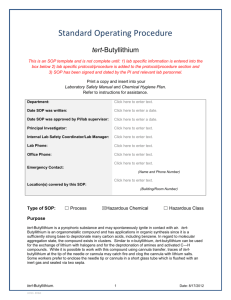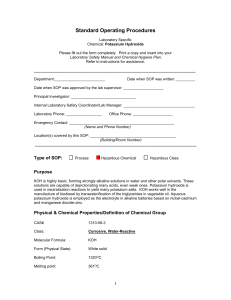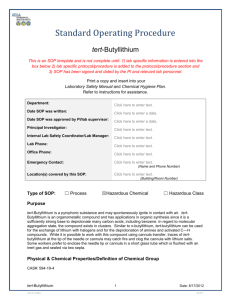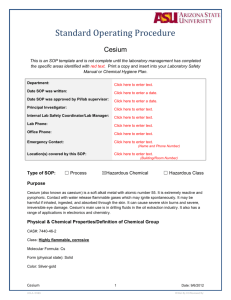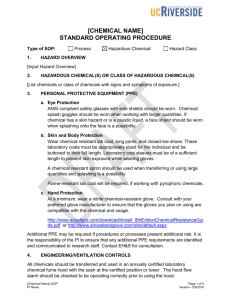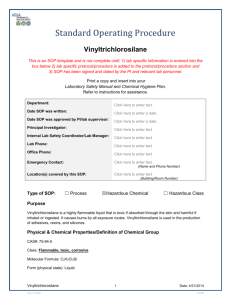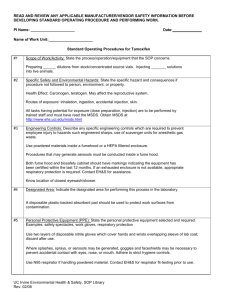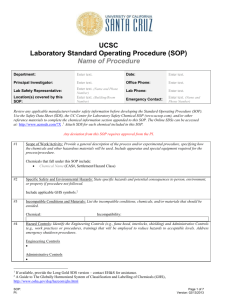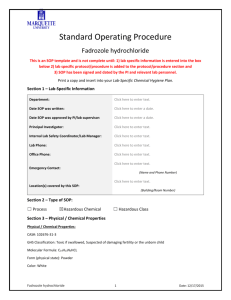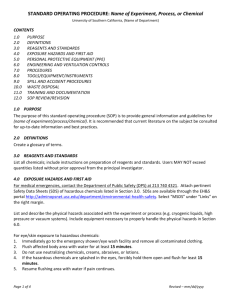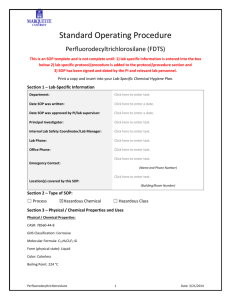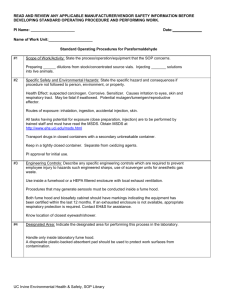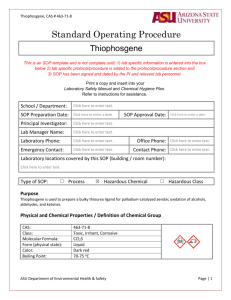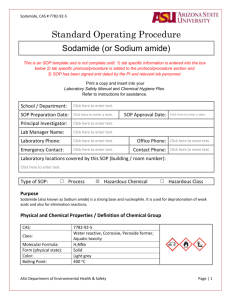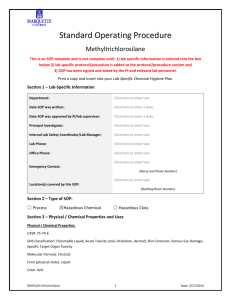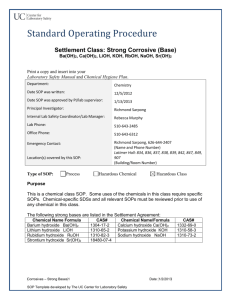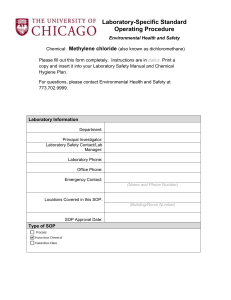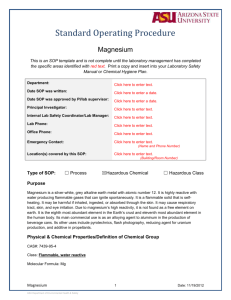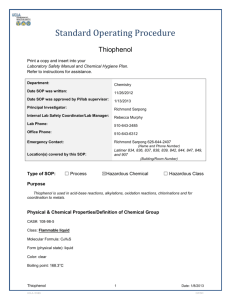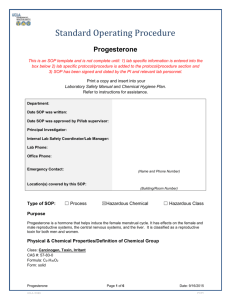Medical Emergency Dial 911
advertisement
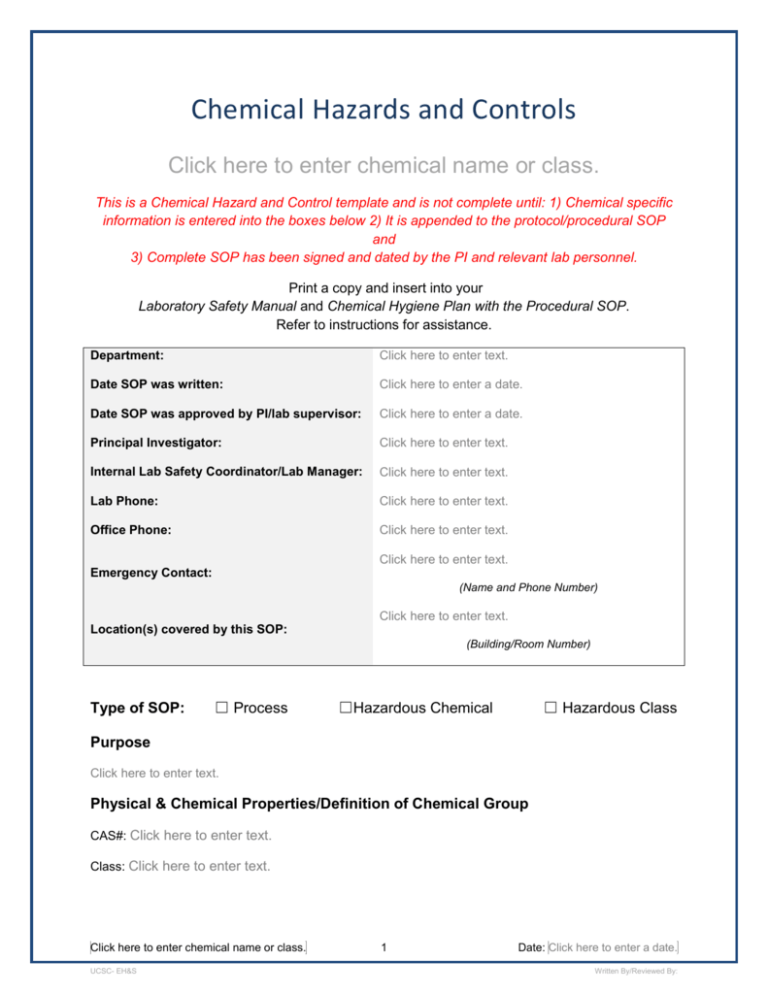
Chemical Hazards and Controls Click here to enter chemical name or class. This is a Chemical Hazard and Control template and is not complete until: 1) Chemical specific information is entered into the boxes below 2) It is appended to the protocol/procedural SOP and 3) Complete SOP has been signed and dated by the PI and relevant lab personnel. Print a copy and insert into your Laboratory Safety Manual and Chemical Hygiene Plan with the Procedural SOP. Refer to instructions for assistance. Department: Click here to enter text. Date SOP was written: Click here to enter a date. Date SOP was approved by PI/lab supervisor: Click here to enter a date. Principal Investigator: Click here to enter text. Internal Lab Safety Coordinator/Lab Manager: Click here to enter text. Lab Phone: Click here to enter text. Office Phone: Click here to enter text. Click here to enter text. Emergency Contact: (Name and Phone Number) Click here to enter text. Location(s) covered by this SOP: (Building/Room Number) Type of SOP: ☐ Process ☐Hazardous Chemical ☐ Hazardous Class Purpose Click here to enter text. Physical & Chemical Properties/Definition of Chemical Group CAS#: Click here to enter text. Class: Click here to enter text. Click here to enter chemical name or class. UCSC- EH&S 1 Date: Click here to enter a date. Written By/Reviewed By: Molecular Formula: Click here to enter text. Form (physical state): Click here to enter text. Color: Click here to enter text. Boiling point: Click here to enter text. Potential Hazards/Toxicity Click here to enter text. Personal Protective Equipment (PPE) Respirator Protection Click here to enter text. Respirators should be used only under any of the following circumstances: As a last line of defense (i.e., after engineering and administrative controls have been exhausted). When Permissible Exposure Limit (PEL) has exceeded or when there is a possibility that PEL will be exceeded. Regulations require the use of a respirator. An employer requires the use of a respirator. There is potential for harmful exposure due to an atmospheric contaminant (in the absence of PEL) As PPE in the event of a chemical spill clean-up process Lab personnel intending to use/wear a respirator mask must be trained and fit-tested by EH&S. This is a regulatory requirement. (http://map.ais.ucla.edu/go/1004655) Hand Protection Click here to enter text. NOTE: Consult with your preferred glove manufacturer to ensure that the gloves you plan on using are compatible with Click here to enter chemical name or class. Refer to glove selection chart from the links below: http://www.ansellpro.com/download/Ansell_8thEditionChemicalResistanceGuide.pdf OR http://www.allsafetyproducts.biz/page/74172 OR http://www.showabestglove.com/site/default.aspx OR http://www.mapaglove.com/ Eye Protection Click here to enter text. Skin and Body Protection Click here to enter text. Hygiene Measures Click here to enter text. Click here to enter chemical name or class. UCSC- EH&S 2 Date: Click here to enter a date. Written By/Reviewed By: Engineering Controls Click here to enter text. First Aid Procedures If inhaled Click here to enter text. In case of skin contact Click here to enter text. In case of eye contact Click here to enter text. If swallowed Click here to enter text. Special Handling and Storage Requirements Click here to enter text. Spill and Accident Procedure Chemical Spill Dial 911 Once spilled all liquid or solid pyrophoric chemicals will instantly ignite. Spill– Dial 911 and ask for EH&S assistance x459-2553 for assistance. Chemical Spill on Body or Clothes – Remove clothing and rinse body thoroughly in emergency shower for at least 15 minutes. Seek medical attention. Notify supervisor and EH&S via 911 immediately. Chemical Splash Into Eyes – Immediately rinse eyeball and inner surface of eyelid with water from the emergency eyewash station for 15 minutes by forcibly holding the eye open. Seek medical attention. Notify supervisor and EH&S via 911 immediately. Medical Emergency Dial 911 Life Threatening Emergency, After Hours, Weekends And Holidays – Dial 911. Note: All serious injuries must be reported to EH&S via 911 within 8 hours. Non-Life Threatening Emergency–. For employees, follow the instructions at the Risk Services website: http://risk.ucsc.edu/workerscomp/injuryreportinghowto.html Note: All serious injuries must be reported to EH&S within 8 hours. Needle stick/puncture exposure (as applicable to chemical handling procedure)– Wash the affected area with antiseptic soap and warm water for 15 minutes. Follow he instructions http://risk.ucsc.edu/workerscomp/injuryreportinghowto.html Click here to enter chemical name or class. UCSC- EH&S 3 Date: Click here to enter a date. Written By/Reviewed By: For mucous membrane exposure, flush the affected area for 15 minutes using an eyewash station. Note: All needle stick/puncture exposures must be reported to EH&S within 8 hours. Decontamination/Waste Disposal Procedure Contaminated instruments and benches should be decontaminated with soap and water. All waste and contaminated disposables should be disposed of as hazardous waste according to the guidelines below. General hazardous waste disposal guidelines: Label Waste Affix an on-line hazardous waste tag on all waste containers using the Online Tag Program http://otp.ucop.edu/ as soon as the first drop of waste is added to the container Store Waste Store hazardous waste in closed containers, in secondary containment and in a designated location Double-bag dry waste using transparent bags Waste must be under the control of the person generating & disposing of it Dispose of Waste Dispose of regularly generated chemical waste within 90 days Call EH&S at x9-3086 for questions Empty Containers o Dispose as hazardous waste if it once held extremely hazardous waste (irrespective of the container size) http://ehs.ucsc.edu/waste_management/pubs/EHS%20HWGuidlines/HW-GUIDE.pdf Prepare for transport to pick-up location Check on-line waste tag Write date of pick-up on the waste tag Use secondary containment Safety Data Sheet (SDS) Location Online SDS can be accessed at: http://www.ucmsds.com/?X . NOTE Any deviation from this Procedural/Chemical Handling SOP requires approval from PI. Documentation of Training (signature of all users is required) Prior to conducting any work with Click here to enter chemical name or class., designated personnel must provide training to his/her laboratory personnel specific to the hazards involved in working with this substance, work area decontamination, and emergency procedures. The Principal Investigator must provide his/her laboratory personnel with a copy of this SOP and a copy of the SDS provided by the manufacturer. The Principal Investigator must ensure that his/her laboratory personnel have attended appropriate laboratory safety training or refresher training within the last one year. Click here to enter chemical name or class. UCSC- EH&S 4 Date: Click here to enter a date. Written By/Reviewed By: I have read and understand the content of this SOP: Name Click here to enter chemical name or class. UCSC- EH&S Signature 5 Date Date: Click here to enter a date. Written By/Reviewed By:
